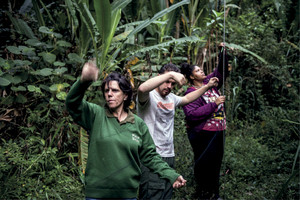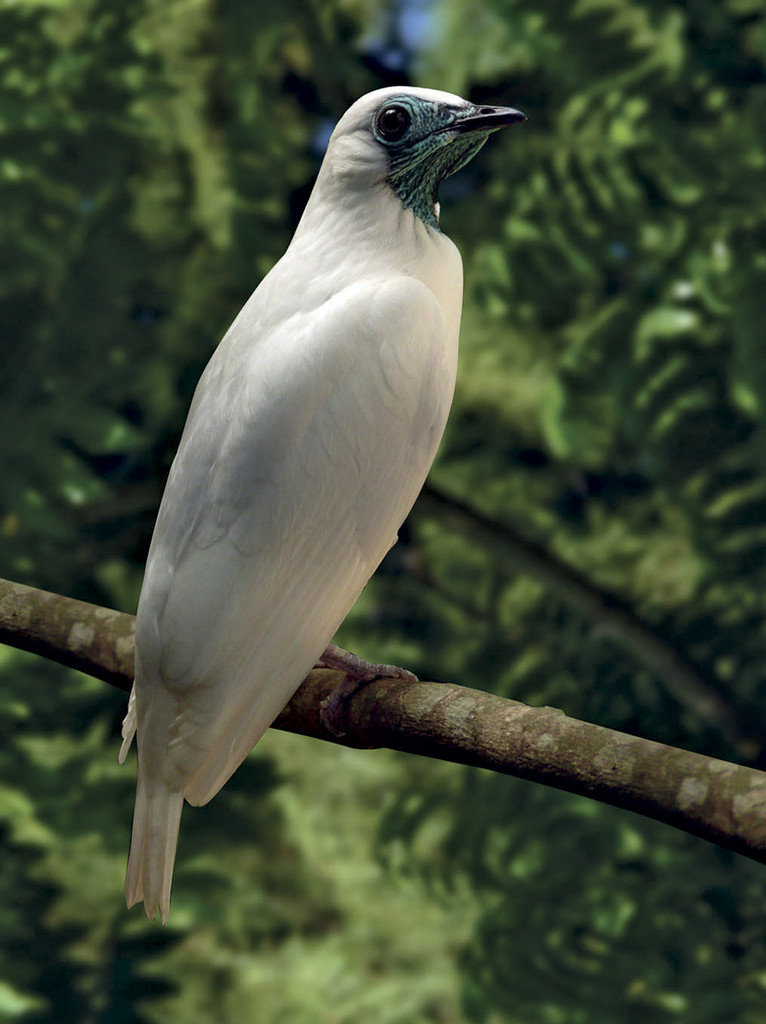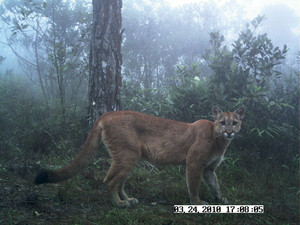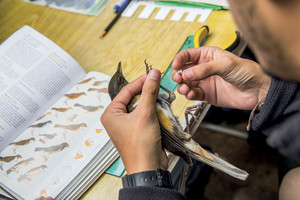While walking along one of the trails in the Manequinho Lopes Vivarium in Ibirapuera Park in the city of São Paulo, biologist Anelisa Magalhães looks for a frequent visitor that had not yet shown up on that rainy April morning. “Oh there it is, all curled up,” she exclaims upon glimpsing an owl at the top of a tree. The bird represents one of the 1,113 species of wild creatures that inhabit plazas, parks, and other green space in the city of São Paulo. This contingent was recorded during an effort that Magalhães and her team began 26 years ago in the fauna division of the city’s Department of Parks and Green Spaces (DEPAVE), and contributed to the December 2016 publication of the Inventário da biodiversidade do município de São Paulo [Inventory of biodiversity in the city of São Paulo] that appeared in an edition of the city’s official gazette.
The inventory also lists 4,768 plant species, 3,584 of which are native to the city. They were identified and recorded by teams coordinated by biologist Ricardo Garcia, curator of the Municipal Herbarium, who has been in the field since the mid-1980s. This is the first time that the Municipal Department of Green and the Environment has published a single document containing records of plant and animal species identified in 138 areas of the São Paulo capital. The survey is intended to assist in the development of biodiversity conservation strategies that could be used as a tool for monitoring the environment in the metropolis. “We hope the data will be used in environmental education programs and research on urban ecology, for example,” Magalhães suggests.
The inventory compiles information collected during surveys conducted in previous years, but also introduces new features. One of the most significant new elements is the report that 92 of the animal species recorded are on the list of endangered species for the state of São Paulo. Although on the one hand there is danger, on the other hand, promising surprises have been observed. The report identified large mammals once thought to have become extinct in the city. This is the case of the jaguar (Panthera onca), located in the Curucutu Unit of Serra do Mar State Park in the extreme southern zone of the city. The jaguar was spotted in January 2016 by a team from the Pró-Carnívoros organization. Its presence suggests that biodiversity in the region may be exhibiting a higher degree of conservation than in the past, Magalhães comments. A similar discovery was made in 2010 when a city government team visiting the Capivari-Monos preserve identified specimens of the Southern Muriqui, also known as the Wooly Spider Monkey, a primate endemic to the Atlantic Forest.
The survey of flora also attracted attention. “We identified 35 species that had never before been documented,” says Garcia. Among them are Hypochaeris albiflora, of the family Asteraceae (the same as the sunflower and daisy), Bulbostylis subtilis, of the family Cyperaceae, and Marlierea regeliana, of the family Myrtaceae. Eighteen plant species in the capital city are exclusive to the Cerrado savannah, five of which were recently recorded as found in natural environments. Mimosa debilis, of the family Fabaceae, is one example.

…and recorded by city biologists who are collecting data on the flora and fauna of the cityEduardo Cesar
The richness of biodiversity in the state capital is not evident only in sites near the so-called “green belt” of São Paulo, where there are areas of dense forest such as the Cantareira and Itapetí mountains. The inventory shows that in localities with a predominance of urban areas, a wide variety of wild plants and animals can also be seen, surviving amid all those buildings and asphalt. “This may be the inventory’s main contribution,” says biologist Carlos Joly, a professor at the University of Campinas (Unicamp). “The survey indicates that even in a big city like São Paulo, one can still have contact with nature. A lot of people think that being exposed to biodiversity means traveling to Amazonia,” Joly adds. He coordinates the Biota-FAPESP research program that describes, preserves, restores, and makes sustainable use of biodiversity.
Specimens of birds typical of more dense forests, such as the bellbird, fruit crow and red-breasted toucan can be found in the Ibirapuera, Aclimação, Buenos Aires, Independência, Burle Marx and Villa-Lobos parks. Magalhães recalls that when she graduated in 1990, field studies conducted in the city focused on areas that were well protected and preserved. There was, at the time, a bird guide for the campus of the University of São Paulo (USP), compiled by zoologist Elizabeth Hofling, and a survey of the birds of the Cantareira. “Those locales were studied because they were the headquarters of research institutions such as USP and the Forestry Institute. The team from City Hall was the first to tame the forest remnants of the southern zone as well as the municipal urban parks,” says Magalhães. “At first, people thought we only had pigeons, vultures, and rats in the city, in other words, fauna considered to be of less ecological importance.”

A bellbird, a typical bird of the Atlantic Forest, can be seen flying over parks in the São Paulo state capital cityMarcos Kawall
Specimens of wild birds have managed to survive in the city, thanks to its parks. In many of them, heterogenous thickets characterized by groupings of native and exotic trees are the predominant vegetation. “Those green islands serve as natural vivaria for species that need shade,” Garcia explains. Those locales, he says, act as “trampolines” for birds, insects, and bats that help with pollination and the dispersion of seeds. Pedro Develey, executive director of the NGO BirdLife/Save Brasil, argues that the arrival of toucans and bellbirds in the city is an indication that it still has environments that can house wild species, despite the advance of urbanization. “This information ought to serve as a warning to government officials,” suggests Develey. “It clearly shows the importance of putting into practice more tree-planting projects that connect the remaining fragments of vegetation.”
In the recent past, surveys of flora and fauna were useful in policy development. Between 1999 and 2003, the Atlas ambiental do município de São Paulo [Environmental atlas of the city of São Paulo] was produced as a result of work conducted by the municipal Department of Green and the Environment as well as the Department of Planning, in partnership with researchers from USP and assistance from the Biota-FAPESP program. The findings were considered in formulating the city’s Master Plan and the Municipal Policy on the Environment. Earlier, in 1993, biologists from City Hall had all participated in an initiative that helped expand the FAPESP-funded survey on plant species, the state of São Paulo Phanerogamic Flora Project, which mobilized about 200 researchers and resulted in descriptions of about 2,000 phanerogamic (flower-producing) species observed among native vegetation.
In recent years, other municipalities—such as Curitiba, Campinas, and Guarulhos—have begun to survey their own species of flora and fauna. “Our inventory was published a few months ago. We are still in the initial phase of presenting the data to academicians and government officials,” Magalhães points out. One of the first researchers to use the recently-published data is ecologist Jean-Paul Metzger from the USP Biosciences Institute. “I’m using the inventory in undergraduate courses. Students analyze the data to identify factors that influence biodiversity within the city of São Paulo,” Metzger explains.

Rare recording of a puma made in Serra do Mar State Park in the extreme south of the city: threatened with extinction in BrazilDEPAVE/City of São Paulo
When compared with other kinds of animals, birds lead in number of species in the city, totaling 458. For that reason, and because of the ease with which they can be observed and heard, they occupy a prominent position in the analyses of the inventory that Magalhães’s team has made. “Birds are good indicators of the quality of the city’s environment,” she says. During the period 1993-2016, for example, experts observed the colonization by some species that previously were rare and had then become quite common, such as the picazuro pigeon (Patagioenas picazuro), which is found in the Cerrado, in the Caatinga Scrubland, and in gallery forests—the ones that form along watercourses. That pigeon was recorded in Ibirapuera Park in the city of São Paulo for the first time in 1993, and is now common throughout the city. Another wild pigeon often seen in the Cerrado and the Caatinga, which ultimately came to live in the city, is the eared dove (Zenaida auriculata).
Help from the public
The team led by Magalhães took advantage of data collected by bird watchers that had been deposited in WikiAves, a database containing records of more than 1,800 Brazilian species, accompanied by 1.9 million photos taken by more than 26,000 users (see Pesquisa FAPESP Issue No. 245). “That was the first time that we supplemented our information with data furnished by amateurs,” the researcher explains. In 2016, the Citizen Scientist monitoring program sponsored by the NGO Save Brasil expanded its activities by forging a partnership with the Butantan Institute and the city government of São Paulo, through DEPAVE, and launched an initiative dubbed Vem Passarinhar (“come go birding”) (#vempassarinhar), staging bird watching excursions in city parks. Those activities involve a walk, followed by breakfast with all the other participants and a presentation about the species observed.
Like DEPAVE, the Butantan Institute has used data collected during that experience in its monthly monitoring of bird species. This monitoring is part of a program started almost three years ago that updates an inventory of flora and fauna of the plant and animal species found in the Institute’s park. “We perform a task similar to what DEPAVE does in the municipality of São Paulo, except in our case we are looking through a magnifying glass at the biodiversity present on the grounds of the institute, which occupies an 80-hectare tract, 60 hectares of which are dense forest,” explains biologist Erika Hingst-Zaher, a researcher at the Biological Museum of that institution. The purpose, she says, is to collect more accurate data on the wild species found on the property and use it in the park’s vegetation and fauna management initiatives. “We would like to increase the diversity of fauna at the institute and to do that we need to be completely familiar with what we have here now,” Hingst-Zaher explains.
Biologist Luciano Lima explains that since the start of the survey at Butantan, more than 150 species of birds have been observed at the site. “Many of those species are on the list but do not live at there all year. So we see the importance of the institute’s park as a refuge for migratory species that come from Amazonia or from Brazil’s Northeast,” says Lima. In addition to birds, the inventory also focuses on other species of animals, like spiders, bats, and butterflies. But, according to Lima, birds are what make the biggest impression on people’s eyes and ears. “Just while we have been talking here, some six species of birds have been singing out there.”
Republish

